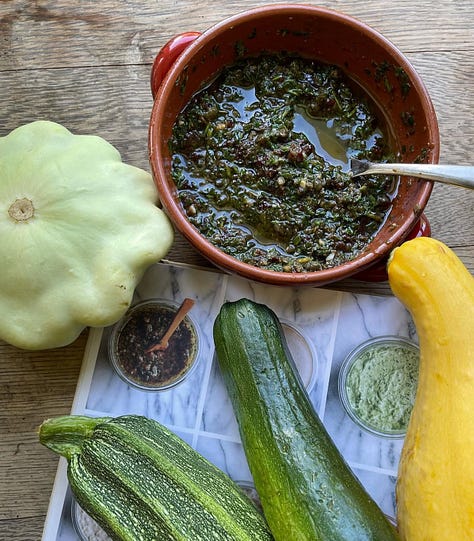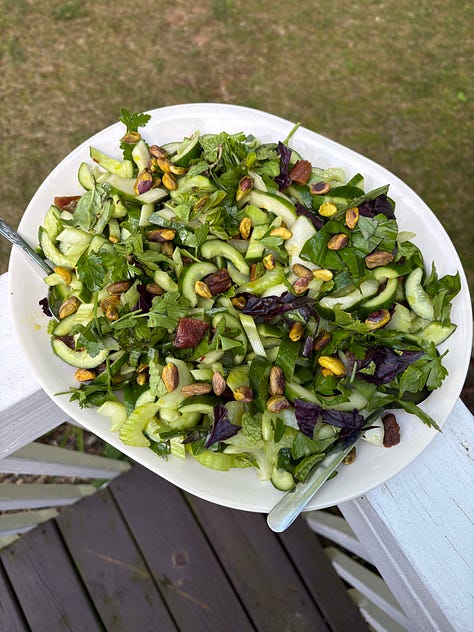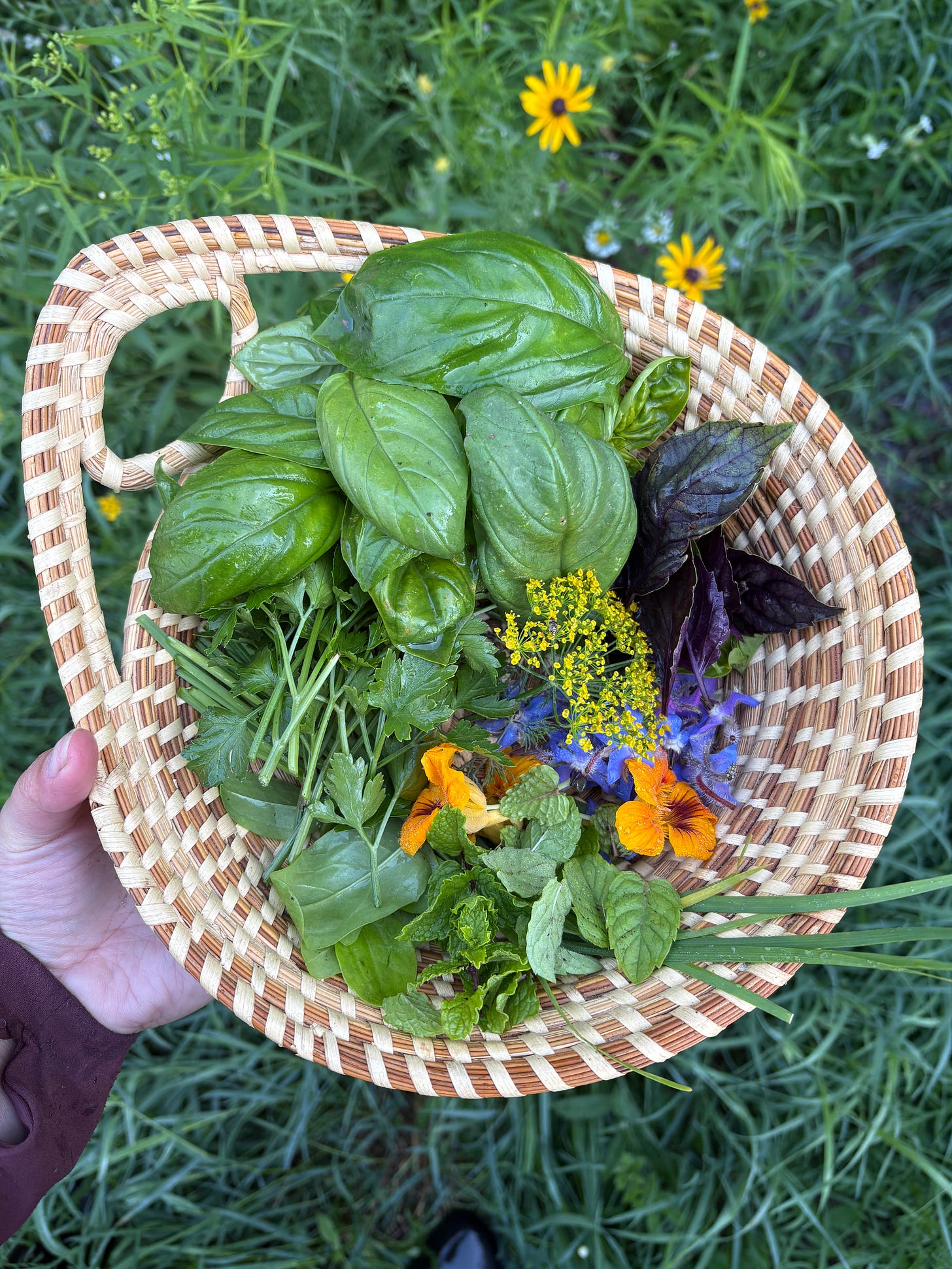Savor the Seasons Cookbook Club #7
Featuring Six Seasons: A New Way with Vegetables by Joshua McFadden
Welcome to the Michelle Seguin MD newsletter! If you’re new here, I’m so glad you’ve joined us. Our community continues to grow, with over 1K members across 48 states and 38 countries. This week, I’m featuring one of my all-time favorite cookbooks, Six Seasons by Joshua McFadden. Whether you’re harvesting from your backyard or picking up produce at the co-op, there’s something here for you.
Hello friends,
We’re just past the midpoint of summer, and while the garden isn’t overflowing quite yet, there’s momentum building. The recent rains have brought lushness to the landscape. Bean vines are stretching, herbs are thick with fragrance, and the calendula blooms brighten the beds with vibrant yellows and oranges. But the vegetables are still taking their time.
This month’s cookbook, Six Seasons, is one of my all-time favorites (definitely in my top five). The spine is broken, the pages are splattered, and its presence in my kitchen is surely that of an old friend. It’s where I learned to make compound butters, quick pickled vegetables, and my go-to Spiced Green Sauce. McFadden doesn’t just offer recipes. He offers a new way of seeing. He teaches us that vegetables have micro-seasons, and that there’s a difference between the first zucchini of July and the prolific flush of August. He reminds us that flavor, like life, shifts subtly with time.
This one is coming to you a little later than usual, as we’re entering an exciting new season in our lives. I’ll share more about that in next week’s newsletter. There’s no Kitchen Conversation this month, but I’m thrilled to share that I have three inspiring guest interviews lined up for the rest of the year.
With gratitude,
Dr. Michelle
A New Way with Vegetables
Before Joshua McFadden became a celebrated chef, he spent a formative season farming with Eliot Coleman at Four Season Farm on the coast of Maine. That time on the farm shaped his deep respect for vegetables and seasonal rhythms. You can feel it on every page of Six Seasons. This is a book written by someone who has pulled carrots from the ground and turned them into a delicious dish to pass.
His “six seasons” framework (spring, early summer, midsummer, late summer, fall, and winter) grew from this kind of close observation. It’s the kind of noticing that comes from growing your own food, when ripeness is something you sense with your hands rather than mark on a calendar. McFadden reminds us that vegetables are not static. They shift with time, light, and temperature. And when we slow down enough to notice, we begin to respond to those changes in intuitive and nourishing ways.
That same rhythm exists within our bodies. Just as a tomato in July is different from one in September, our needs shift with the season. What supports us in midsummer may not be what we need come fall. I see it all the time in the clinic, and I feel it in my own rhythms too.
What I love most about Six Seasons is that McFadden invites us to use what we have, to follow our senses, and to stay open to what feels good. His recipes are flexible and grounded. They leave room for improvisation. And in a season that can feel full and fast, this kind of simple, attentive cooking can help bring us back to center.
What’s on the Menu
This month, I leaned into what the garden had to offer: mostly herbs, edible flowers, and early greens. I paired them with produce from our local co-op and nearby growers. These recipes reflect the early generosity of midsummer and are easy to adapt based on what’s available in your own kitchen.
▪ Smashed Broccoli and Potatoes with Parmigiano and Lemon (page 176)
We served this on a chilly, rainy night alongside grilled Polish sausage and lemon dill kraut. It was hearty, bright, and deeply satisfying. The smashing technique creates crisp edges and caramelized flavor, especially when cooked in a cast iron skillet or on a Blackstone griddle.
From a nutritional standpoint, broccoli adds fiber and sulfur-rich compounds that support detoxification. Potatoes offer grounding starch and prebiotic fiber. Lemon brings a boost of vitamin C, and Parmigiano contributes calcium and a touch of gut-friendly support.
Dr. Annie Fenn wrote a fantastic overview on the best cheeses for brain health in her newsletter last week. Hint - Parmigiano Reggiano is on the list!
▪ Cucumbers, Celery, Apricots, and Pistachios (page 196)
This refreshing salad was a beautiful side for a lakeside cookout with family this past weekend, and it was a hit! The garden-fresh herbs really made it sing, and they even traveled well in a bento box in the cooler (I love this one). Hydrating cucumbers and celery help replenish fluids and provide a touch of natural electrolytes, including sodium, potassium, and magnesium. Apricots bring beta-carotene and gentle sweetness. Pistachios round things out with healthy fats, fiber, and plant-based protein. I’m adding this one into my summer sides rotation.
▪ Grilled Wax and Green Beans with Tomatoes, Basil, and Spicy Fish-Sauce Sauce (page 208)
We haven’t made this one yet, since our beans are still climbing and not quite ready. But it’s bookmarked for later this summer. The combination of charred beans, juicy tomatoes, and umami-rich fish sauce sounds like everything I want in an easy weeknight dish. From a health perspective, it’s packed with antioxidants, phytonutrients, and digestion-supporting herbs like basil. I’ll report back once we give it a try.
▪ Grilled or Roasted Summer Squash with Caper-Raisin Vinaigrette (page 211)
The vinaigrette is what makes this dish memorable. Sweet golden raisins, briny capers, and a touch of vinegar create a complex finish that brings the squash to life. Summer squash is rich in water and fiber, which support hydration and digestion during hot weather. Capers contribute antioxidants, while the raisins offer polyphenols and natural sugars that are gentler on blood sugar than processed sweets. Try tossing the squash on the grill when it’s already hot to make quick work of another tasty, seasonal side.



1. Smashed Broccoli and Potatoes with (generous) Parmigiano and Lemon 2. Summer Squash with Caper-Raisin Vinaigrette 3. Cucumbers, Celery, Apricots, and Pistachios
Let’s Reflect
Whether you cooked along this month or simply followed with curiosity, I’d love to invite you to pause and consider:
What does abundance mean to you in this season of life?
When the pace of midsummer feels intense, what helps you stay grounded?
Is there a vegetable you’ve struggled with or avoided? What might it look like to approach it with curiosity?
How has your relationship with seasonal eating changed over time?
In Closing
The garden teaches us to meet the moment as it is. Even in a year with a slow start, there is still something to harvest, something to notice, something to savor. Six Seasons reminds us that nourishment isn’t just about peak ripeness. It’s also about how we engage with what’s present, whether in the soil, on our plates, or within ourselves.
Next week, I’ll share what we’ll be cooking together in August. It will be a reader’s choice selection, chosen by our paid subscribers.
Paid subscribers: I’ll be opening the voting pool tomorrow. Keep an eye on your inbox for a notice!
Until then, may your kitchen feel like a place of creativity and care, and may the season continue to unfold with generosity and grace.
With love and care,
Dr. Michelle
P.S. If this letter resonated with you, I’d love it if you gave it a like or shared it with a friend. The Savor the Seasons Cookbook Club continues to grow into a joyful, curious community. I’m so glad you’re here!
Here are my most recent Substack sharings:






You do a wonderful job of describing the dishes you share, I felt like I was cooking right alongside you! We might have to do that sometime here on Substack live! I, eyeing that cucumber salad with fresh apricots, I need to try that before the end of summer for sure.
Just added this cookbook to my list!!